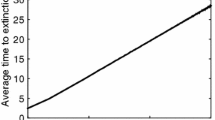Abstract
Tipping points have been shown to be ubiquitous, both in models and empirically in a range of physical and biological systems. The question of how tipping points cascade through systems has been less explored and is an important one. A study of noise-induced tipping, in particular, could provide key insights into tipping cascades. Here, we consider a specific example of a simple model system that could have cascading tipping points. This model consists of two interacting populations with underlying Allee effects and stochastic dynamics, in separate patches connected by dispersal, which can generate bistability. From an ecological standpoint, we look for rescue effects whereby one population can prevent the collapse of a second population. As a way to investigate the stochastic dynamics, we use an individual-based modeling approach rooted in chemical reaction network theory. Then, using continuous-time Markov chains and the theory of first passage times, we essentially approximate, or emulate, the original high-dimensional model by a Markov chain with just three states, where each state corresponds to a combination of population thresholds. Analysis of this reduced model shows when the system is likely to recover, as well as when tipping cascades through the whole system.









Similar content being viewed by others
References
Abraham R (1991) Cuspoidal nets. In: Thygesen N et al (eds) Business cycles. Springer, Berlin, pp 56–63
Allen LJS (2010) An introduction to stochastic processes with applications to biology. CRC Press, Boca Raton
Allen LJS, Allen EJ (2003) A comparison of three different stochastic population models with regard to persistence time. Theor Popul Biol 64(4):439–449
Boukal DS, Berec L (2002) Single-species models of the allee effect: extinction boundaries, sex ratios and mate encounters. J Theor Biol 218(3):375–394
Chou T, D’Orsogna MR (2014) First passage problems in biology. In: Metzler R, Oshanin G, Redner S (eds) First-passage phenomena and their applications. World Scientific, Singapore, pp 306–345
Courchamp F, Clutton-Brock T, Grenfell B (1999) Inverse density dependence and the allee effect. Trends Ecol Evol 14(10):405–410
Courchamp F, Berec L, Gascoigne J (2008) Allee effects in ecology and conservation. Oxford University Press, Oxford
Dai L, Vorselen D, Korolev KS, Gore J (2012) Generic indicators for loss of resilience before a tipping point leading to population collapse. Science 336(6085):1175–1177
Drake JM, Kramer AM (2011) Allee effects. Nat Educ Knowl 3:2
Gardiner CW (2004) Handbook of stochastic methods: for physics, chemistry and the natural sciences. Springer, Berlin
Gillespie DT (1976) A general method for numerically simulating the stochastic time evolution of coupled chemical reactions. J Comput Phys 22(4):403–434
Gillespie DT (1977) Exact stochastic simulation of coupled chemical reactions. J Phys Chem 81(25):2340–2361
Hastings A, Gross L (2012) Encyclopedia of theoretical ecology. University of California Press, Berkeley
Holling CS (1973) Resilience and stability of ecological systems. Annu Rev Ecol Syst 4(1):1–23
Johnson CL, Hastings A (2018) Resilience in a two-population system: interactions between allee effects and connectivity. Theor Ecol 11(3):281–289
Klose AK, Karle V, Winkelmann R, Donges JF (2020) Emergence of cascading dynamics in interacting tipping elements of ecology and climate. R Soc Open Sci 7(6):
Lenton TM (2020) Tipping positive change. Philos Trans R Soc B 375(1794):20190123
MATLAB (2020) R2020a. The MathWorks Inc., Natick
Méndez V, Assaf M, Masó-Puigdellosas A, Campos D, Horsthemke W (2019) Demographic stochasticity and extinction in populations with allee effect. Phys Rev E 99(2):
Odum HT, Allee WC (1954) A note on the stable point of populations showing both intraspecific cooperation and disoperation. Ecology 35(1):95–97
O’Regan SM (2018) How noise and coupling influence leading indicators of population extinction in a spatially extended ecological system. J Biol Dyn 12(1):211–241
Polizzi NF, Therien MJ, Beratan DN (2016) Mean first-passage times in biology. Isr J Chem 56(9–10):816–824
Rocha JC, Peterson G, Bodin Ö, Levin S (2018) Cascading regime shifts within and across scales. Science 362(6421):1379–1383
Scheffer M (2009) Critical transitions in nature and society, vol 16. Princeton University Press, Princeton
Scheffer M, Carpenter SR, Lenton TM, Bascompte J, Brock W, Dakos V, Van de Koppel J, Van de Leemput IA, Levin SA, Van Nes EH et al (2012) Anticipating critical transitions. Science 338(6105):344–348
Strogatz S (2001) Nonlinear dynamics and chaos: with applications to physics, biology, chemistry, and engineering (studies in nonlinearity). Westview Press, Boulder
van Doorn EA, Pollett PK (2013) Quasi-stationary distributions for discrete-state models. Eur J Oper Res 230(1):1–14
Van Kampen NG (1992) Stochastic processes in physics and chemistry. Elsevier, Amsterdam
Volterra V (1938) Population growth, equilibria, and extinction under specified breeding conditions: a development and extension of the theory of the logistic curve. Hum Biol 10(1):1–11
Vortkamp I, Schreiber SJ, Hastings A, Hilker FM (2020) Multiple attractors and long transients in spatially structured populations with an allee effect. Bull Math Biol 82(6):1–21
Acknowledgements
The authors would like to thank the anonymous referee for extensive and valuable feedback that improved the manuscript.
Author information
Authors and Affiliations
Corresponding author
Ethics declarations
Conflict of interest
The authors declare no conflicts of interest.
Additional information
Publisher's Note
Springer Nature remains neutral with regard to jurisdictional claims in published maps and institutional affiliations.
Rights and permissions
About this article
Cite this article
Mallela, A., Hastings, A. The Role of Stochasticity in Noise-Induced Tipping Point Cascades: A Master Equation Approach. Bull Math Biol 83, 53 (2021). https://doi.org/10.1007/s11538-021-00889-1
Received:
Accepted:
Published:
DOI: https://doi.org/10.1007/s11538-021-00889-1




